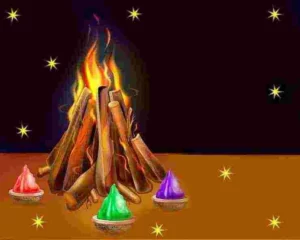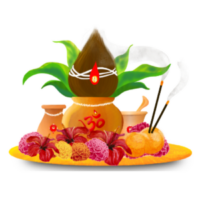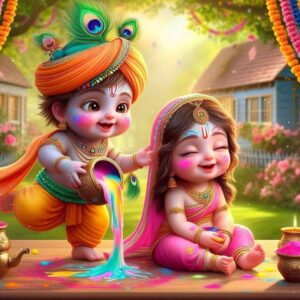🌻The Story of Holika and Prahlad—the Holika Dahan Legend 🌻

According to Hindu mythology, this colorful festival is observed as a plea to Lord Vishnu and Prahalad, his most ardent devotee. Hiranyakashyapa, a demon king who claimed to be God and wished for universal devotion, was the father of Prahlad.
Prahalad disliked the fact that he was a devoted follower of Lord Vishnu. His father possesses some benefits, such as the ability to be unaffected by people, animals, weapons, or other means. No matter the time of day—morning, afternoon, evening, or night—he cannot be tricked.
He was unbeatable on land, in the water, and in the air, but not indoors. All these powers made him arrogant, and he started considering himself eternal and stating he was a self-god.
Since he killed those who prayed to him, everyone in his realm began to worship him as a deity out of dread of dying, but his own son disobeyed him and kept worshiping Lord Vishnu. He tried to break his faith in God by harshly punishing him and teaching him a lesson, but his attempts were ineffective.
In the end, he told his sister Holika to burn him alive. Because Prahalad possessed the superpower that fire could not burn her, Holi ordered her to be confined in the pyre. But as soon as the fire was ignited, Prahalad started chanting lord Vishnu’s name “Om Hari,” which provided him protection from fire, and being Holika wrong in spite of protection, got charred to death. Burning Holika thus represents good triumphing over evil and refers to burning all wicked and harmful surroundings.
***
🌻The Sacrifice of Kamadeva 🌻
According to Hindu mythology, the planet is guarded by the Trinity of Gods: Lord Brahma, who created the world; Lord Vishnu, who nurtures it; and Lord Shiva, who destroys it.
According to legend, Goddess Sati married Lord Shiva against her father’s desires. She was the daughter of Daksha Prajapati, one of Lord Brahma’s first sons. Consequently, Daksha refused to invite her and her spouse to a sumptuous yagya that he had organized. Sati thought it was an error when she heard about the party at her father’s house, and she decided to go in spite of her husband’s warnings.
However, she realized her error there and became furious when she heard her spouse disparage her. In order to make amends for her misbehavior, she entered the fire. The news of her premature death infuriated Lord Shiva. Even after mastering the art of controlling his anger, he abandoned all of his work and started a rigorous meditation regimen.
Without him, the world’s equilibrium rapidly collapsed, and Sati sought to win Lord Shiva’s love and rouse him from his slumber by taking on the persona of Goddess Parvati. She tried everything to get Shiva’s attention.
When she had run out of feminine options, she turned to Kamadava, the Hindu god of love, who chose to be by her side in spite of the risks. He used his love arrow to pierce Shiva’s heart.
Lord Shiva burned Kamadeva after his meditation was disrupted, thus offering his life as a sacrifice for the good of the universe. Lord Shiva gave Kamadeva immortality in an unseen form after realizing his error.
***
🌻 The Story of Krishna and Radha — The Color Fight Legend Story🌻
This is the lovely tale of Holi, the festival’s color. Young Krishna is very mischievous and lively. According to the story, Sri Krishna was quite dark as a youngster and was therefore envious of Radha’s pale skin and celestial beauty. He would constantly gripe to his mother about how nature had unfairly given him a dark complexion, whereas Radha had been blessed with a lovely, fair complexion.
Mother Yashoda playfully offered that he paint Radha’s face any color he desired when he heard the innocent voice of infant Krishna and saw his dejected expression. Krishna, who was constantly looking for pleasure, didn’t want to miss this opportunity. Mischievous Krishna painted Sri Radha’s lovely face a variety of hues to make her look like him. All of the Gopis supported Radha and did not oppose him, but they gradually gave in to Krishna’s enhanced personality and began to take pleasure in the game of color.
Everyone in Vrindavan was drawn to this affectionate game between Sri Krishna and Radha, and they all enjoyed the game of colors and became enthralled with Lord Sri Krishna’s celestial Maya. It quickly rose to prominence as one of the village’s most well-liked celebrations, and as Sri Krishna’s divinity grew, the celebration expanded throughout the nation.
But when Krishna was born, he wasn’t that dark. His black complexion has a backstory as well. Once, a demon offered little Krishna poisoned milk in an attempt to murder him. The poison turned Krishna blue but was unable to kill him. But little Krishna’s enthusiastic touch was worth the devil’s death.
Since ancient times, Holi has been joyfully celebrated throughout India. It comes in the middle of spring on a full moon day. Regardless of caste, color, status, creed, race, or sex, individuals from a variety of backgrounds and social strata come to this color festival. When all barriers to discrimination are removed, people gather and apply colored powder to one another, fostering a sense of fraternity and community. As of right now, it appears that there is no separation among the inhabitants of the planet. Everyone thinks about love, fraternity, unity, and affection when they celebrate this event.
***
🌻Chasing Away the Ogress Dhundhi—A Story Loved by Children🌻
Around Holi, the story of the Ogress Dhundi is very well-known, particularly with children.
Under Prithu’s control, Dhundi was all but unbreakable, but for her vulnerability to the wild energy and mischievousness of young boys. The King of Raghu was especially disturbed by this monstrosity. In order to kill the monster, a priest proposed that all of the boys be sent out to gather firewood and start a fire at the start of the spring. Then, until she leaves, the boys should encircle the fire and applaud, yell, laugh, beat drums, insult her, and so forth.
This is the reason that on the day of Holi, intoxication is typical, and young males are still permitted to act raucously and use foul language.
***

